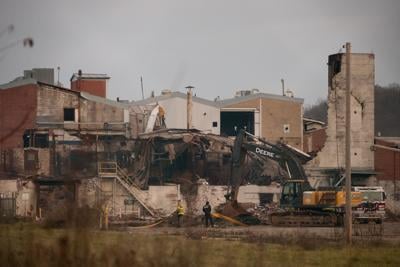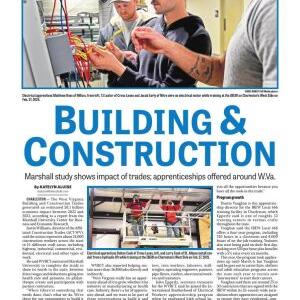HUNTINGTON �����Ƶ� The City of Huntington has officially taken action to call for remediation on the former Flint Group pigments property after deeming it a public nuisance before it caught on fire days later on Christmas.
The city filed a complaint for injunction in Cabell County Circuit Court on Wednesday against Everett Hannah Properties II LLC and its owner, Everett Hannah, concerning the public safety of the property in the 2400 block of 5th Avenue.
The city seeks injunctive relief in the form of an order holding that the property and the several industrial buildings at the address are a public nuisance and should be removed.
The city seeks a mandatory injunction against the company, directing it to secure the property with fencing, remove the dilapidated and unsafe buildings, board and secure all remaining buildings and abate the nuisance so that it is no longer a danger to the public.
According to the complaint, Everett Hannah Properties II LLC�����Ƶ�s principal office is located in Varney, West Virginia, and Hannah has sole control over the company�����Ƶ�s properties.
According to the complaint, the city believes Everett Hannah II LLC is not adequately capitalized for risks of owning a dilapidated industrial site, particularly one that is unsecure and attractive to trespassers. The complaint also says the LLC does not carry liability insurance coverage or property insurance coverage (for the primary risks of the business).
The city asks that all buildings hazardous to public health and safety on the property be abated.
On Dec. 23, 2024, the Huntington City Council approved a resolution to deem the property a public nuisance under West Virginia Code. The resolution was brought before the council to pursue legal action to require the owner of the property to remove any unsafe or collapsing buildings.
�����Ƶ�Our top priority is the safety and well-being of our residents. When a property owner neglects to address serious hazards, the city has a responsibility to act," Huntington Mayor Patrick Farrell said Thursday. "This property was deemed a public nuisance because of the clear risks it posed to the community �����Ƶ� risks that tragically became reality when the building caught fire, putting both our first responders and the public in danger. This action sends a clear message: we will not tolerate threats to our city�����Ƶ�s safety.�����Ƶ�
Acting City Attorney Scott Damron said during a public safety committee meeting in December that various buildings on the property were in disrepair, partially torn down or collapsed and full of junk and trash. Affidavits from city Fire Marshal Alan Roby and Todd Darst, supervisor/chief building inspector, shared sentiments that several buildings are a fire hazard and environmental concern.
The affidavits showed pictures of the collapsed buildings with trash littered around the property. According to the complaint, the city also found evidence of trespassing, property damage, drugs, housing code violations, weeds taller than a foot, combustible materials and vacant, dilapidated and collapsing buildings.
On Dec. 25, 2024, a large fire started in one of the buildings.
Before the Christmas Day fire, at least two of the buildings on the property were partially demolished and deemed unstable and actively collapsing. Several others had very large holes in the exterior walls, decreasing stability and leaving access to trespassers, the complaint states.
Hazardous materials tanks still exist on the property, along with debris and trash. The fence around the lot is not closed, making the entire property unsecured and easily accessible by transient people, which has occurred and was verified by city officials, the complaint states.
The building damaged by the most recent fire has been knocked to the ground, but the debris remains.
�����Ƶ colder months continue, it is expected that more transients will seek shelter on the property and build warming fires, putting the structures at risk of yet another fire, the complaint said.
�����Ƶ of Wednesday, when the complaint was filed, the cause of the Christmas Day fire had not been determined; however, it validates the city�����Ƶ�s concerns over the dangerous condition of this site, according to the complaint.
The plant at 5th Avenue formerly made a pigment called alkali blue for a variety of uses. Originally named Standard Ultramarine & Color Co., the plant began production in 1912 on a half-acre site but soon grew to cover 20 acres and employed more than 500 people. By 1948, Standard Ultramarine (also known as SUCO) offered a variety of pigments.
In 1964, SUCO was sold to Chemetron Corp. and combined with Holland Color & Chemical to form Holland-SUCO Color Co., a name that was used until 1969 when it was changed to the Pigments Division of Chemetron. In 1979, Chemetron sold the plant to BASF Wyandotte.
Flint Group acquired the plant from BASF in 2005 and closed the plant in 2017. Over the years, several buildings have been demolished, leaving large open areas.
According to the complaint, the current owner allowed a salvage company to enter the property to salvage the property in 2022.
�����Ƶ�The salvage operation included the removal of very large items such as conveyors and vats, which was accomplished by going through the exterior walls of buildings, leaving gaping holes and causing partial demolition,�����Ƶ� according to an affidavit of Darst, the building inspector.
Hannah has 30 days to respond, according to the complaint. The court will then hold a hearing to determine whether to grant a temporary injunction. If granted, the case will proceed to further litigation or a final hearing on the merits of the injunction request, depending on the court�����Ƶ�s decision, according to the West Virginia Judiciary website.













